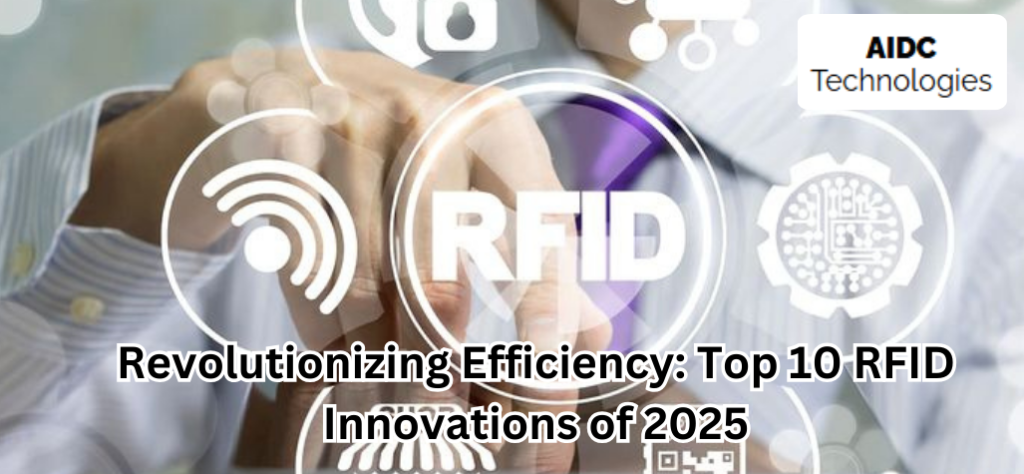Table of Contents
Toggle
Introduction to RFID Technology
Radio Frequency Identification (RFID) technology has been revolutionising industries for years, and in 2025, its role is more crucial than ever. RFID uses radio waves to find and keep track of things, making it easy to keep track of inventory, assets, and processes. It eliminates the need for manual scanning or line-of-sight visibility, helping companies gain real-time visibility and automation. In this blog, we’ll explore the top 10 RFID Definitions in 2025 and how they are shaping modern industries.
1. RFID: Radio Frequency Identification
The most basic of all RFID Definitions is the technology itself—Radio Frequency Identification. Radio waves can be used by RFID to send data from a reader to a tag. This contactless process speeds up item tracking, enhances security, and reduces errors in industries ranging from retail to healthcare.
2. Passive RFID
Passive RFID tags operate without a battery. The radio signal from the RFID reader gives them life. Among modern RFID Definitions, passive RFID is valued for its low cost and scalability. In 2025, industries like supply chain, retail, and asset tracking continue to rely on passive RFID due to its cost-effectiveness.
3. Active RFID
Active RFID tags can be used for tracking over long distances because they have their power source. This definition of RFID is commonly used in logistics, defence, and construction, where real-time monitoring is vital. Active RFID supports location tracking, alerting systems, and real-time decision-making.
4. RFID Tags
One of the most common RFID Definitions relates to RFID tags—tiny devices attached to products or assets. Available as passive, active, or semi-passive, these tags store unique data that identifies the object. In 2025, RFID tags are smaller, more durable, and increasingly integrated into packaging.
5. RFID Reader
RFID readers are devices that capture information from RFID tags. A key part of RFID Definitions, readers can be handheld, fixed, or integrated into machines. Modern readers offer faster data transfer, cloud connectivity, and support for multiple protocols, making asset monitoring more intelligent.
6. RFID Middleware
Middleware is the software that connects RFID hardware to enterprise applications. In 2025, RFID Definitions include middleware as a vital tool to filter, store, and route data. This layer ensures only relevant information is sent to your warehouse, ERP, or inventory systems.
7. Real-Time Location System (RTLS)
RTLS is a specialised term in modern RFID Definitions. It uses RFID to pinpoint the exact location of assets, people, or tools within a facility. Industries like healthcare and manufacturing rely on RTLS to minimise downtime, prevent loss, and improve overall safety and accountability.
8. Electronic Product Code (EPC)
It is one of the most accurate RFID Definitions to use the Electronic Product Code. It’s a unique number encoded into RFID tags that distinguishes each product. EPC helps businesses avoid duplication, manage stock, and enable global supply chain standardisation.
9. RFID in Supply Chain Management
One of the most applied RFID Definitions in practice involves supply chains. RFID enables better inventory visibility, real-time shipment tracking, and faster processing at warehouses. In 2025, RFID is becoming the backbone of digital supply chains worldwide.
10.RFID Security and Privacy
As RFID expands, so does the need for security and privacy. In updated RFID Definitions, this refers to protection from data theft, unauthorised scanning, and tag cloning. To make RFID systems safe, businesses now use security and access control.
How RFID Transforms Industries
RFID technology is expected to continue evolving in 2025, transforming industries by improving operational efficiency, reducing costs, and enhancing the customer experience. For example:
- Retail: RFID allows retailers to track inventory in real-time, preventing stockouts and improving supply chain visibility.
- Healthcare: RFID is used to track medical equipment, improve patient care, and ensure compliance with safety regulations.
- Logistics and Warehousing: RFID improves inventory accuracy, reduces human error, and speeds up the movement of goods in warehouses and distribution centres.
- Libraries and Government Offices: RFID enhances asset tracking, reduces downtime, and ensures better quality control throughout the production process.
Conclusion
Understanding these top 10 RFID Definitions in 2025 helps businesses unlock the full potential of smart tracking and automation. As the demand for real-time data and efficiency grows, RFID will play an even greater role in revolutionising industries. By adopting the right solutions and working with trusted partners like AIDC Technologies India, companies can future-proof their operations and stay competitive in a digital world.
Book now with AIDC Technologies India and discover smart, future-ready RFID systems designed just for you.
FAQs
Q1. What is the difference between passive and active RFID?
Active RFID uses a battery to operate across greater distances, whereas passive RFID depends on the reader and has no power supply.
Q2. Is RFID safe for data privacy?
Yes, in 2025, most RFID systems use encryption and security protocols to ensure data safety.
Q3. Can RFID be used outdoors?
Yes. RFID systems, especially active tags, are suitable for outdoor and harsh environments.
Q4. Which industries use RFID the most?
Retail, healthcare, logistics, warehousing, government, and manufacturing are key adopters.
Q5. Why choose AIDC Technologies for RFID solutions?
AIDC offers industry-specific RFID tools, expert guidance, and complete integration support, making them a trusted choice for businesses in India.